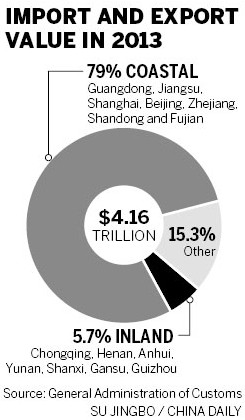

Export growth in the landlocked central and western regions will continue to outpace the coastal area driven by ongoing industrial transfers into the inland regions and the government's opening-up strategies in these areas, experts said.
"The coastal area, which was the forerunner of China's reforms and opening-up in past decades, witnessed fast trade growth. But rising costs, including land and labor costs, are driving industrial businesses into the central and western regions with their cheaper utility costs and lower wages," said Zhang Jianping, a researcher at the Institute for International Economic Research at the National Development and Reform Commission.
Zhang added that the transfer of industry would continue in the near future as businesses in China's eastern region as well as in other countries move into China's inland areas, supporting a faster export growth there.
He noted that labor-sensitive businesses, such as textiles, garments and electronic components, as well as labor-intensive industries such as large-scale infrastructure, are the major forces behind industrial relocation to the inland regions. But high-tech businesses are also well-established in some inland cities, including Chengdu, Chongqing and Xi'an.
"Compared with the eastern region, the investment environment of the inland regions is undoubtedly less well-developed. But compared with neighboring countries, it is improving very significantly. As the government keeps improving governmental functions, streamlining investment approvals and increasing transparency, the inland regions will unleash greater potential for investors," Zhang said.
Dai Binxiang, a researcher at Southwest Jiaotong University, agreed, saying the low export base of inland regions also helped aid robust growth after enterprises engaged in export business moved there en masse.
Foxconn Technology Group, a major supplier for electronics giants including Apple Inc, set up a plant in Zhengzhou, in Central China's Henan province, in 2010 and now employs more than 300,000 workers with 90 percent from the heavily populated province. In 2012, the company built a production plant in Chengdu, in Southwest China's Sichuan province, making use of the cheap labor in the region.
In January, exports from Guangdong province, which accounts for more than one-fifth of China's overall goods trade, dropped 6.4 percent from a year earlier. In the same period, exports from Central China's Jiangxi province surged 60.4 percent, and those from Sichuan province rose 41.2 percent, according to the General Administration of Customs.
However, seven eastern regions - Guangdong province, Jiangsu province, Shanghai, Beijing, Zhejiang province, Shandong province and Fujian province - continue to account for the bulk of China's overall trade, at about 76.7 percent of January's goods trade value.
Zheng Yusheng, a spokesman for the customs administration, said at a recent briefing that trade in the central and western regions is becoming more dynamic and the country's regional structure of trade more balanced.
Throughout 2013, the seven eastern regions accounted for 79 percent of the country's total goods trade value, down 0.9 percentage points from the previous year. In contrast, seven inland regions - Henan province, Yunnan province, Anhui province, Shaanxi province, Gansu province, Guizhou province and Chongqing - all posted trade growth above 15 percent from a year earlier, compared with the country's overall growth of 7.6 percent. Together they accounted for 5.7 percent of China's total trade value, up 0.6 percentage points from the previous year, Zheng said.
National Development and Reform Commission researcher Zhang noted the central government's strategies of opening the inland and border areas as well as improving ties with Central Asian countries also helped boost trade in the inland regions.
"Neighboring countries have huge demand for Chinese products. The inland regions will be a major force for supplying these products," Zhang said.
In a comprehensive reform plan released late last year, China pledged to expand the opening of inland and border areas while stepping up the construction of the Silk Road Economic Belt and the 21st century Maritime Silk Road, two regional economic blueprints the Chinese government is hoping to create along ancient trade routes linking China to the Mediterranean Sea.
On Thursday, Yao Jian, a spokesman for Ministry of Commerce, said the ministry will facilitate the flow of goods and personnel between China and Central Asia while promoting the use of the yuan in trade settlements. It will also encourage two-way investment, which is expected to boost China's exports of equipment and high-tech products, while expanding its purchases of oil, gas and agricultural products from the region.
Global investors shift their focus inland
2014-02-14Export growth remains robust in inland China
2013-11-08Labor shortages pushes Foxconn inland
2013-03-05